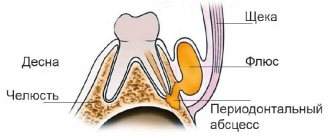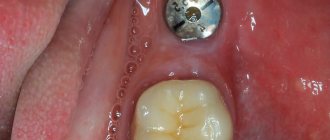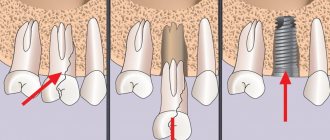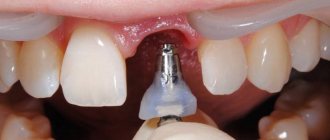Endodontic treatment of tooth roots requires all the knowledge and skill of the dentist. After all, if even the slightest mistake is made, all subsequent work on filling and prosthetics will be done in vain. Our clinic's endodontists have extensive experience in successful root canal treatment and are proud of the good results of their work.
Reasons for performing root canal treatment are:
- deep complicated caries;
- acute and chronic pulpitis;
- periodontitis, etc.
The goal of treatment is to clean the dental ducts and put a filling so that infection does not penetrate into them.
How is the treatment carried out?
The doctor uses special tools to drill a hole in the head of the unit being restored. Through it, it removes diseased pulp and dentin, and also disinfects the outlet space, and then seals it.
There are two main processing methods:
- apical-coronal, i.e. the doctor processes the dental canal from top to bottom, from the head to the mouth of the root;
- coronal-apical, i.e. on the contrary - from bottom to top.
The key to a high-quality procedure is accurate diagnosis of the roots, which is ensured by radiography. The picture is taken before, during and after the procedure. This is necessary in order to assess the length and shape of the dental outlet as accurately as possible. After all, these indicators are individual for each person.
During the procedure, antimicrobial agents are used that have the following effects:
- destroy harmful microflora;
- improve the condition of the preserved tissues of the unit;
- do not cause allergic reactions.
Our clinic actively uses laser technologies, which give excellent results.
They carefully remove dead remains of pulp and dentin without damaging living tissue.
Leave your phone number. The clinic administrator will call you back.
By leaving a request on the site, you consent to the processing of personal data
Make an appointment
Initial consultation
400 rubles
The image shows poorly treated root canals in the lower sixth unit.
BEFORE AFTER
BEFORE AFTER
How long does it take to treat caries?
A lot has been said and said about caries. But it is little known how the process of healing a tooth from this disease occurs. Let's quickly look at the main points - how long it takes to treat caries, how filling and further restoration of the tooth occurs. Caries is an infectious process
, which leads to tooth destruction and, if left untreated for a long time, inevitably leads to its removal.
There are 3 main stages of caries depending on the depth of the lesion: 1. Superficial - within the upper layers of enamel. 2. Middle - within the dentin (its upper and middle third). 3. Deep - the layer closest to the pulp, when damaged further, pulpitis occurs. Conventionally, depending on the localization and prevalence of the process, 5 classes according to Black are distinguished (in honor of the person who invented them) 1. Chewing surface 2. Chewing-contact surface. 3. On the contact surface of the front tooth, without involving the cutting edge in the process. 4. Class 3, but with the involvement of the cutting edge 5. Cervical surface of all teeth. Of course, all these lesions can be combined, so the classification is rather arbitrary, and the doctor during the treatment process makes a final verdict regarding the depth and extent of the spread of the process. So, the stages of treatment of deep caries in time.
1. Anesthesia, the effect of which occurs in approximately 4-10 minutes. 2. Mechanical treatment of the tooth with a brush and paste, or sandblasting to remove plaque (soft and hard). This stage takes 3-5 minutes 3. Determining the color of the future restoration - 2 minutes 4. Isolation of the working field using a rubber dam system - 3 minutes 5. How long does it take to drill and fill a tooth? - you ask. Yes, this stage of mechanical treatment (removal of carious tissue) is the most exciting and causes tremors in the body before the onset of anesthesia. It lasts about 10 minutes, and please note that at the moment it is absolutely painless. 6. Antiseptic treatment of the cavity with the addition of a product based on calcium hydroxide as a cushioning material to initiate the formation of a layer of dentin above the pulp and relieve inflammation in it. It occurs inevitably, since infection penetrates through the dentinal tubules even with minor caries, causing certain changes and reactions. 7. How long does it take to put a filling on a tooth? Placing a filling also consists of several sub-stages: 1) Etching the tooth surface with a special gel for better penetration of the adhesive system - 40 seconds. 2) Installation of the matrix and wedges (if necessary) in case of damage to tooth contacts - according to the timing of 1-2 minutes. 3) Applying a special adhesive (glue) for good fixation of the filling - 2 minutes. It needs to be thoroughly rubbed, inflated and illuminated with a special lamp. 4) Direct layer-by-layer application of material, illumination of each portion for 10 minutes or more, depending on the purpose and planned result. If we are talking about a buildup (restoring a tooth under a crown), where great anatomical accuracy is not required, then such a restoration will take less time. If this is a veneer on a front tooth, where aesthetics are at stake, then the work can last more than one hour. 5) Final grinding and polishing of the surface to give the restoration an ideal anatomical shape and a smooth texture indistinguishable from natural tissues. The stages of treatment for average caries, as well as any other, are approximately the same in time, with the exception of the stage of introducing therapeutic cushioning material. Let's answer the most frequently asked questions about timing: 1) How long does it take to fill a tooth? On average, this procedure lasts from 50 to 1.5 hours, depending on the complexity of the defect being restored. 2) How long does it take to fill the canals of a tooth? This process is called endodontic treatment and is carried out for complicated forms of caries. Time from 1.5 to 3 hours depending on complexity. Naturally, this time is divided into several visits. 3) How long does it take to fill a tooth if it has already been filled (that is, a “dead” tooth with a removed nerve). Again, planning of treatment and time for it will be based on how well and with what the canals were previously sealed, and whether there are any complaints at the time of treatment. The unfilling process can last from several hours, after which medicinal material is introduced into the tooth canals for several weeks. Therefore, the process from start to final recovery can last about a month. 4) How long does it take to fill a tooth if it already has a filling and it is of unsatisfactory quality (sagged, a part chipped, changed color)? In any case, the decision on the possibility of restoring a tooth with a filling in all of the above conditions will be made on the basis of an examination, an image and the degree of tooth decay. If the lesion is small, then the old filling is removed at the very beginning of treatment and replaced with a new restoration. Otherwise, restoration with an orthopedic construction - an inlay, a crown - is required. We talked about how long it takes to fill a tooth in different clinical situations, as well as the main stages of this procedure. Please note that the time indicated above is average and gives you only an approximate idea of the doctor’s work. For more detailed information and drawing up a rehabilitation plan, if you have oral diseases, please contact our Familystom clinic for a face-to-face consultation. We provide high-tech, qualified assistance and create an atmosphere of reliability and calm at all stages of treatment.
Installing a seal
The dentist selects a suitable filling material, which must meet the following requirements:
- have antimicrobial, hypoallergenic properties and high biocompatibility;
- be plastic and airtight at the same time;
- Do not dye the fabric of the unit being restored.
The filling material is varied:
- hardening;
- non-hardening;
- pins made of silver, titanium, gutta-percha, plastic.
When installing a pin, sealants and fillers are used, which are most often made from epoxy resin. First, the doctor uses an endodontic needle to place material into the prepared canal, then the top of the filling is compacted, excess material is removed, polished and adjusted to the bite.
Dental treatment at Dr. Granov’s dental clinic means high quality services and an individual approach to each patient.
How much treatment is possible in 1 visit?
The maximum duration of treatment under sedation is 14 consecutive hours
- Carry out comprehensive oral hygiene
- Cure caries, pulpitis or periodontitis
- Remove dental cysts
- Remove teeth, including wisdom teeth
- Fix the bracket system or aligners
- Install up to 16 implants
- Perform bone grafting on the lower jaw, sinus lift or revision of the maxillary sinus on the upper
- Install a comfortable and beautiful fixed prosthesis supported on your own teeth or on implants
How to treat all teeth in 1 day “in a dream”
Indications for dental canal treatment
Tooth canal treatment is a specific dental procedure that is advisable to perform in the following clinical cases:
When an active inflammatory process is detected inside the root of a dental unit. The inflammatory process in this part of the tooth can lead to gradual tissue necrosis. If tissue necrosis begins, the diseased tooth will have to be removed.
The condition is diagnosed by radiography;
Treatment of tooth canals is required for pulpitis - inflammation affecting the pulp bundle;
Endodontic treatment is carried out for periodontitis, a disease affecting the apical part of the tooth root;
In some cases, cleaning and treatment of dental canals is required for advanced forms of caries.
Dental canal treatment is also indicated for abscesses, the onset of an inflammatory process under an old filling, or a fractured tooth root. The need for measures to treat tooth canals may be indicated by such symptoms as: severe, excruciating pain in the tooth, occurring mainly at night, swelling of soft tissues, discoloration of the gums and tooth enamel.
In some cases, tooth canal treatment is carried out before prosthetics. The nerve is removed from the tooth, and the canal cavities are cleaned, treated with antiseptic drugs and filled.
Who chooses to have all their teeth treated “in their sleep”
For everyone who values their time and is accustomed to a certain quality of life, i.e. for everyone, although 10 years ago this format was of interest only to “big screen” stars and patients from other cities
- Super-busy Muscovites If you don’t have time to go to the dentist, like going to work, in traffic jams, in the evening, 2 times a week for six months to a year to get your teeth in order, and the problem is put off and put off for years
- Patients not from Moscow Every month we accept at least 10 patients from Russia and Europe. The operations are planned remotely; you only need to come for diagnostics and the operation itself. Very comfortably!
- Public people of all professions Privacy, quick results and the absence of visible signs of treatment on the face are why this technique has long been loved by show business stars, politicians, businessmen, and more recently bloggers
- Connoisseurs of comfort You can treat your teeth in the format of a SPA procedure. Fall asleep and wake up when it's all over. Not seeing or remembering the process. Do not hear medical odors and unpleasant sounds. Get the result and go home!
- Parents of responsible children If your parents are also the type who wouldn’t let a dentist near them at the drop of a hat, but walk around without teeth, then the only treatment format they can agree to is “all in 1 visit.” Checked!
- All those who do not like dentists Uncontrollable feelings of fear, panic reactions, negative experiences with a dentist in the past - all this is a direct indication for treatment in medicinal sleep
What manipulations are performed when installing an implant?
The main steps when using the classical technique:
- Introduction of an anesthetic drug.
- Cutting the gums and peeling off the mucoperiosteal flap.
- Formation of the bone bed, with its gradual expansion until the desired size is achieved.
- Periodic irrigation of tissues to prevent overheating of the bone.
- Screwing a metal implant into the hole and installing a plug.
- Placement of mucoperiosteal flaps and suturing.
How long does it take to install a dental implant?
The above manipulations take a total of about 25–35 minutes. But in complicated cases, implant installation is somewhat delayed and can last 40–50 minutes or even an hour.
Also, the operation takes longer if additional combined manipulations are performed. For example, the bottom of the nasal sinus is raised to increase the space for the implant.
The duration of the operation may also increase if the dentist does not yet have much experience in performing such interventions. A highly qualified specialist who has been successfully installing implants for a long time does it quite quickly.










